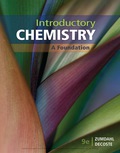
Introductory Chemistry: A Foundation
9th Edition
ISBN: 9781337671323
Author: ZUMDAHL
Publisher: Cengage
expand_more
expand_more
format_list_bulleted
Question
Chapter 1, Problem 13ALQ
Interpretation Introduction
(a)
Interpretation:
A model for the interior mechanism of the box should be constructed based on the observations.
Interpretation Introduction
(b)
Interpretation:
The further experiments could you do to refine your model should be determined.
Expert Solution & Answer
Trending nowThis is a popular solution!

Students have asked these similar questions
For the reaction A (g) → 3 B (g), Kp = 0.379 at 298 K. What is the value of ∆G for this reaction at 298 K when the partial pressures of A and B are 5.70 atm and 0.250 atm?
14. Calculate the concentrations of Ag+, Ag(S2O3), and Ag(S2O3)23- in a solution prepared by mixing
150.0 mL of 1.00×10-3 M AgNO3 with 200.0 mL of 5.00 M Na2S2O3
Ag+ + S20
Ag(S203)¯
K₁ = 7.4 × 108
Ag(S203)¯ + S20¯ = Ag(S203)
K₂ = 3.9 x 104
ΗΝ,
cyclohexanone
pH 4-5
Draw Enamine
I
I
CH3CH2Br
THF, reflux
H3O+
I
Drawing
Draw Iminium Ion
Chapter 1 Solutions
Introductory Chemistry: A Foundation
Ch. 1.4 - What if everyone in the government used the...Ch. 1 - Discuss how a hypothesis can become a theory. Can...Ch. 1 - Make five qualitative and five quantitative...Ch. 1 - Prob. 3ALQCh. 1 - Differentiate between a “theory” and a “scientific...Ch. 1 - Describe three situations when you used the...Ch. 1 - Scientific models do not describe reality. They...Ch. 1 - Theories should inspire questions. Discuss a...Ch. 1 - Describe how you would set up an experiment to...Ch. 1 - If all scientists use the scientific method to try...
Ch. 1 - As stated in the text, there is no one scientific...Ch. 1 - In Section 1.3 the statement is made that it is...Ch. 1 - As part of a science project, you study traffic...Ch. 1 - Prob. 13ALQCh. 1 - Chemistry is an intimidating academic subject for...Ch. 1 - The first paragraphs in this chapter ask you if...Ch. 1 - This section presents several ways our day-to-day...Ch. 1 - The Chemistry in Focus segment titled Dr....Ch. 1 - This textbook provides a specific definition of...Ch. 1 - We use chemical reactions in our everyday lives,...Ch. 1 - Prob. 7QAPCh. 1 - Being a scientist is very much like being a...Ch. 1 - In science, what is the difference between a law...Ch. 1 - Observations may be either qualitative or...Ch. 1 - Prob. 11QAPCh. 1 - True or false? If a theory is disproven, then all...Ch. 1 - Although, in general, science has advanced our...Ch. 1 - Discuss several political, social, or personal...Ch. 1 - Although reviewing your lecture notes and reading...Ch. 1 - Why is the ability to solve problems important in...Ch. 1 - Students approaching the study of chemistry must...Ch. 1 - The ‘Chemistry in Focus” segmentChemistry: An...
Knowledge Booster
Similar questions
- :0: :0: Select to Add Arrows :0: (CH3)2NH :0: ■ Select to Add Arrows :0: :0: (CH3)2NH ■ Select to Add Arrowsarrow_forwardDraw the product of the following H action sequence. Ignore any inorganic byproducts formed. 1. (CH3CH2)2CuLi, THF 2. CH3Br Q Atoms, Bonds and Rings H Charges ㅁarrow_forwardPlease help me with this the problem is so confusingarrow_forward
- 14 Question (1 point) Disiamylborane adds to a triple bond to give an alkenylborane. Upon oxidation with OH, H2O2, the alkenylborane will form an enol that tautomerizes to an aldehyde. In the first box below, draw the mechanism arrows for the reaction of disiamylborane with the alkyne, and in the last box draw the structure of the aldehyde. 4th attempt Feedback i > 3rd attempt OH, H2O2 i See Periodic Table See Hintarrow_forwardanswer with mechanisms and steps. handwritten please!arrow_forwardHello I need some help with Smartwork. For drawing structure B, I know the correct answer is CH₃B₂, but when I try to type it in, it keeps giving me CH₄BH₃ instead. Do you know how I should write it properly? Should I use a bond or something else?arrow_forward
arrow_back_ios
SEE MORE QUESTIONS
arrow_forward_ios
Recommended textbooks for you
 Chemistry: An Atoms First ApproachChemistryISBN:9781305079243Author:Steven S. Zumdahl, Susan A. ZumdahlPublisher:Cengage Learning
Chemistry: An Atoms First ApproachChemistryISBN:9781305079243Author:Steven S. Zumdahl, Susan A. ZumdahlPublisher:Cengage Learning ChemistryChemistryISBN:9781305957404Author:Steven S. Zumdahl, Susan A. Zumdahl, Donald J. DeCostePublisher:Cengage Learning
ChemistryChemistryISBN:9781305957404Author:Steven S. Zumdahl, Susan A. Zumdahl, Donald J. DeCostePublisher:Cengage Learning
 Introductory Chemistry: A FoundationChemistryISBN:9781337399425Author:Steven S. Zumdahl, Donald J. DeCostePublisher:Cengage Learning
Introductory Chemistry: A FoundationChemistryISBN:9781337399425Author:Steven S. Zumdahl, Donald J. DeCostePublisher:Cengage Learning Chemistry & Chemical ReactivityChemistryISBN:9781337399074Author:John C. Kotz, Paul M. Treichel, John Townsend, David TreichelPublisher:Cengage Learning
Chemistry & Chemical ReactivityChemistryISBN:9781337399074Author:John C. Kotz, Paul M. Treichel, John Townsend, David TreichelPublisher:Cengage Learning Chemistry & Chemical ReactivityChemistryISBN:9781133949640Author:John C. Kotz, Paul M. Treichel, John Townsend, David TreichelPublisher:Cengage Learning
Chemistry & Chemical ReactivityChemistryISBN:9781133949640Author:John C. Kotz, Paul M. Treichel, John Townsend, David TreichelPublisher:Cengage Learning

Chemistry: An Atoms First Approach
Chemistry
ISBN:9781305079243
Author:Steven S. Zumdahl, Susan A. Zumdahl
Publisher:Cengage Learning

Chemistry
Chemistry
ISBN:9781305957404
Author:Steven S. Zumdahl, Susan A. Zumdahl, Donald J. DeCoste
Publisher:Cengage Learning


Introductory Chemistry: A Foundation
Chemistry
ISBN:9781337399425
Author:Steven S. Zumdahl, Donald J. DeCoste
Publisher:Cengage Learning

Chemistry & Chemical Reactivity
Chemistry
ISBN:9781337399074
Author:John C. Kotz, Paul M. Treichel, John Townsend, David Treichel
Publisher:Cengage Learning

Chemistry & Chemical Reactivity
Chemistry
ISBN:9781133949640
Author:John C. Kotz, Paul M. Treichel, John Townsend, David Treichel
Publisher:Cengage Learning